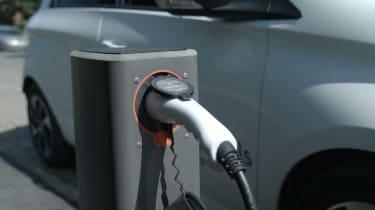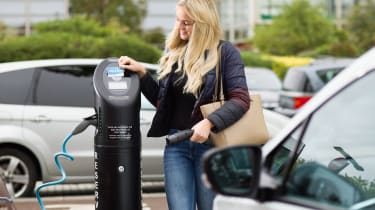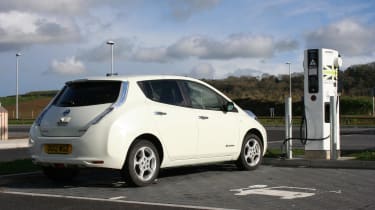The amount of electric cars on the roads has boomed in recent years, and so has the demand for ways to charge them. Many owners charge their electric car from home via a wall box charger on their driveways. If you live in a flat or house and need to charge your electric car without a driveway or any off-street parking, the whole process can become a lot more difficult. Here are our top tips on how to do it.
Depending on your local council’s rules, you may be able to trail a charging cable from your home to your car if it’s in a parking space outside – assuming you can find one that’s close enough. This requires a lot more planning than you might think, however, as you could be found responsible if the lead obstructs someone and causes an accident.
Home charging is not the only way to charge your electric car without a driveway. Under the government’s On-Street Residential Chargepoint Scheme more public charging points are being installed in easily accessible locations for electric car owners who don’t have off-street parking with access to their own chargepoint. There’s also the option of charging your car at other places where you regularly spend a lot of time, like your workplace or the gym.
It’s worth remembering that the sale of new petrol and diesel vehicles is set to be banned in 2030, so the public charging network that is already growing quickly will become much more widespread in the coming years, making it easier to plug-in if you don’t have a driveway at home.
Street charging
Although charging with a cable running from your house to your car outside is not technically illegal, it’s not advisable for a number of reasons. Many local councils require you to remove the charging cable once the vehicle is fully charged, plus you could be found legally responsible if a passer-by gets injured as a result of tripping over the wire, so it’s best not to take the risk.
While it’s also possible to charge an EV through a traditional three-pin socket in your home, it’s highly frowned upon given the risk of fire and extremely slow charging speeds.
If you’re adamant about running a charging cable across the pavement you’ll need a cable that’s long enough to reach without an extension lead and it would be wise to place an anti-trip cover over the cable if it crosses a public right of way.
The Electric Vehicle Homecharge Scheme (EVHS) was replaced in April 2022 by the EV Chargepoint Grant. The grant contributes up to 75% of the cost of a home chargepoint or wallbox to a cap of £350 – this was previously available to owners of electric vehicles with a house, but is now only available to EV owners living in rented accommodation or a flat. Crucially, however, the owner must have ‘dedicated off-street parking at their property’. So it’s not available to homeowners without private parking who are hoping to run a cable out to the street from their wallbox.
On-Street Residential Chargepoint Scheme

Many councils have taken advantage of the On-Street Residential Chargepoint Scheme and are installing more and more charging points around cities to promote the uptake of new electric vehicles. It’s true that a typical EV still takes longer to charge than refuelling a petrol or diesel car, but this solution allows owners of electric cars to top them up while they’re parked.
The scheme enables councils to install charging points in discrete locations like lamp-posts, kerb-side pillars or even pavements where they can be retracted away while they’re not in use.
You’ll still need to bring your own cable to use these charge points, and the charging speeds will vary depending on the area.
Charging while at work

Another government scheme exists, known as the ‘Workplace Charging Scheme’, to promote the installation of charging stations for use while you’re at work, so it’s worth asking your employer or suggesting the idea to them.
Businesses eligible for this grant can save up to £300 for a maximum of 20 sockets, which makes the prospect much more enticing for business-owners. With the rise in popularity of working from home, it also offers an incentive for employees to return to the office. It makes sense to charge your car while you’re busy so it’s ready to go by the end of the working day.
Other places where people spend a lot of time include gyms, supermarkets and shopping centres. Many gyms now offer charging facilities in their car parks to use while you work out and this is even included as part of some gym membership plans. It’s worth checking what’s included in your plan if you’re a gym-goer. Supermarkets and shopping centres have also started installing public charging points as a way to entice shoppers, so there are plenty of places to charge your EV.
The public charging network

With the ban on the sale of new petrol and diesel vehicles fast approaching in 2030, the public charging network will inevitably become just as widespread as petrol and diesel fuel stations are now. You’re less likely to have a driveway in places with higher population density, but this is also where the most public charging points tend to be.
The other benefit to public charging stations is that charging speeds are quicker than home charging, with fast, rapid and ultra-rapid charging available for compatible cars. The number of public chargers increased by 335% between the end of 2016 and 2021, and the majority of these installations are fast chargers. The infrastructure is continually expanding.
The ever-increasing number of charging stations means it’s easier for customers to shop around – the price tends to vary depending on charging speed and location. The fastest chargers can be quite expensive, particularly those around the motorway network but these are really only for a quick top-up that will get you home. In most cases charging an electric car is significantly cheaper on a cost-per-mile basis than refuelling a petrol or diesel car so EV owners should save on running costs even if they are forced to rely on public chargers.
Now you’ve read about how to charge your car without a driveway, check out our guide to fast and rapid charging and different charger types…
